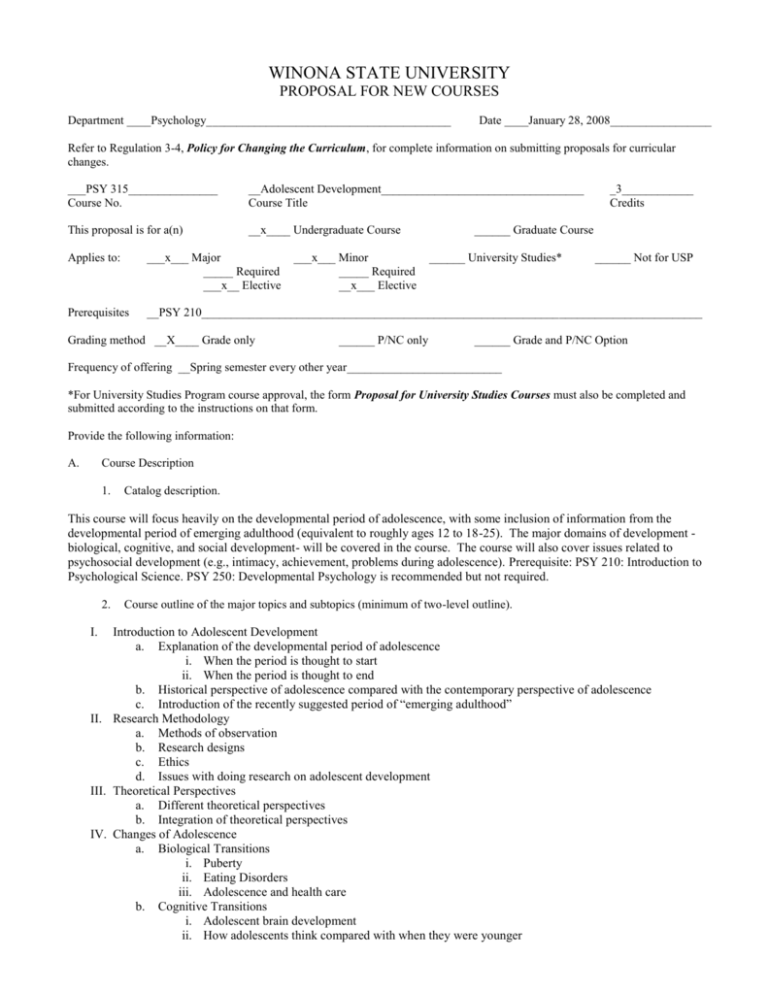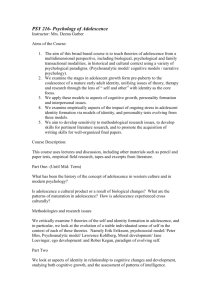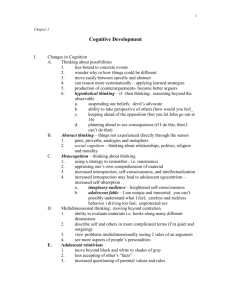
WINONA STATE UNIVERSITY
PROPOSAL FOR NEW COURSES
Department ____Psychology_________________________________________
Date ____January 28, 2008_________________
Refer to Regulation 3-4, Policy for Changing the Curriculum, for complete information on submitting proposals for curricular
changes.
___PSY 315_______________
Course No.
__Adolescent Development__________________________________
Course Title
This proposal is for a(n)
__x____ Undergraduate Course
______ Graduate Course
Applies to:
___x___ Major
_____ Required
___x__ Elective
Prerequisites
__PSY 210____________________________________________________________________________________
Grading method __X____ Grade only
___x___ Minor
_____ Required
__x___ Elective
_3____________
Credits
______ P/NC only
______ University Studies*
______ Not for USP
______ Grade and P/NC Option
Frequency of offering __Spring semester every other year__________________________
*For University Studies Program course approval, the form Proposal for University Studies Courses must also be completed and
submitted according to the instructions on that form.
Provide the following information:
A.
Course Description
1.
Catalog description.
This course will focus heavily on the developmental period of adolescence, with some inclusion of information from the
developmental period of emerging adulthood (equivalent to roughly ages 12 to 18-25). The major domains of development biological, cognitive, and social development- will be covered in the course. The course will also cover issues related to
psychosocial development (e.g., intimacy, achievement, problems during adolescence). Prerequisite: PSY 210: Introduction to
Psychological Science. PSY 250: Developmental Psychology is recommended but not required.
2.
I.
Course outline of the major topics and subtopics (minimum of two-level outline).
Introduction to Adolescent Development
a. Explanation of the developmental period of adolescence
i. When the period is thought to start
ii. When the period is thought to end
b. Historical perspective of adolescence compared with the contemporary perspective of adolescence
c. Introduction of the recently suggested period of “emerging adulthood”
II. Research Methodology
a. Methods of observation
b. Research designs
c. Ethics
d. Issues with doing research on adolescent development
III. Theoretical Perspectives
a. Different theoretical perspectives
b. Integration of theoretical perspectives
IV. Changes of Adolescence
a. Biological Transitions
i. Puberty
ii. Eating Disorders
iii. Adolescence and health care
b. Cognitive Transitions
i. Adolescent brain development
ii. How adolescents think compared with when they were younger
iii. How context influences adolescents’ thinking
Social Transitions
i. Changes in social status
ii. Transition to adulthood
1. Emerging Adulthood
V. Contexts of Adolescent Development
a. Families
i. Familial relationships
ii. Adolescents and contemporary familial changes
b. Peers
i. History of adolescent peer groups
ii. Crowds and cliques
iii. Social status
c. Schools
i. History of education
ii. Organization of schools
iii. Schools and adolescent development
iv. College and non-college
d. Work and Leisure
i. Adolescents and work
ii. Adolescents and leisure
e. Mass Media
i. Violent media
ii. Sexuality
iii. Body Image
VI. Interpersonal Development
a. Identity
i. Relation to adolescence
ii. Changes
b. Autonomy
i. Relation to adolescence
ii. Changes
c. Intimacy
i. Relation to adolescence
ii. Changes
iii. Romantic relationships
d. Sexuality
i. Relation to adolescence
ii. Changes
e. Achievement
i. Relation to adolescence
ii. Changes
f. Psychosocial Problems in Adolescence
i. Externalizing problem behavior
ii. Internalizing problem behavior
iii. Alcohol and drug use
c.
3.a Instructional delivery methods utilized: (Please check all that apply).
Lecture: Auditorium
ITV
Online
Lecture: Classroom x
Service Learning
Travel Study
Other: (Please indicate)
3.b. MnSCU Course media codes: (Please check all that apply).
None: X
3. Internet
1. Satellite
4. ITV Sending
2. CD Rom
5. Broadcast TV
Web Enhanced
Laboratory
6. Independent Study
7. Taped
8. ITV Receiving
4. Course requirements (papers, lab work, projects, etc.) and means of evaluation.
Web Supplemented
Internship/Practicum
9. Web Enhanced
10. Web Supplemented
I.
II.
III.
IV.
V.
Exams
a. 3 unit exams
b. 1 final exam
Quizzes
a. Weekly: questions will be drawn from the reading only
Papers
a. 2 short papers (2-3 pages)
Group Discussions
a. 6 structured small group discussions designed to allow students to practice critical thinking and oral
communication skills
In-Class Activities
a. 8 small in-class activities
Provisional Course Requirement Points
Course Requirements
Exams
3 Semester Exams
Final Exam
Quizzes
12 Quizzes
Papers
2 papers
Group Project
2 Work Days
1 Project
In-Class Activities
8 ICAs
5.
Points
Course Percentage
3 x 50 points = 150 points
1 x 50 points = 50 points
50%
12 x 5 points = 60 points
15%
2 x 20 = 40 points
10%
2 x 10 points = 20 points
1 x 40 points = 40 points
5%
10%
8 x 5 points = 40 points
10%
Course materials (textbook(s), articles, etc.).
Textbooks:
Arnett, J. J. (2002). Readings on adolescence and emerging adulthood. Upper Saddle River, NJ: Pearson-Prentice Hall.
Steinberg, L. (2008). Adolescence (8th ed.). Boston, MA: McGraw Hill.
Alternative Textbook:
Santrock, J. W. (2007). Adolescence (11th ed.). Boston, MA: McGraw Hill.
Example Articles:
Arnett, J. J. (2000). Emerging adulthood: A theory of development from the late teens through the twenties. American
Psychologist, 55(5), 469-480.
Flanagan, C. A., & Faison, N. (2001). Youth civic development: Implications of research for social policy and programs. Social
Policy Report, 15(1), 1-14.
Lerner, R. M. (2002). Appendix: Studying adolescent development: Methods and designs. In Adolescence: Development,
diversity, context and application (pp. 376-399). Upper Saddle River, N.J.: Pearson-Prentice Hall.
Shulman, S., & Kipnis, O. (2001). Adolescent romantic relationships: A look from the future. Journal of Adolescence, 24, 337351.
6.
I.
Assessment of Outcomes
Exams, quizzes, papers, group discussions, in-class activities
II. Course evaluations
7.
List of references.
Adams, G. R., & Berzonsky, M. D. (Eds.). (2003). Blackwell handbook of adolescence. Malden, MA: Blackwell Publishing.
Arnett, J. J. (2007). Adolescence and emerging adulthood: A cultural approach (3rd ed.). Upper Saddle River, NJ: PearsonPrentice Hall.
Crouter, A. C., & Booth, A. (Eds.). (2006). Romance and sex during adolescence and emerging adulthood: Risks and
opportunities. Mahwah, NJ: Lawrence Erlbaum Associates, Publishers.
Garrod, A. C., Smulyan, L., Powers, S. I., & Kilkenny, R. (2005). Adolescent portraits: Identity, relationships, and challenges
(5th ed.). Boston, MA: Pearson.
McWhirter, J. J., McWhirter, B. T., McWhirter, E. H., & McWhirter, R. J. (2004). At-risk youth: A comprehensive response
(3rd ed.). Belmont, CA: Brooks/Cole-Thomson Learning.
Mortimer, J. T., & Larson, R. W. (Eds.). (2002). The changing adolescent experience: Societal trends and the transition to
adulthood. New York, NY: Cambridge University Press.
Rice, F. P., & Dolgin, K. G. (2008). The adolescent: Development, relationships, and culture (12th ed.). Boston, MA: Pearson.
Stickle, F. E. (Ed.). (2007). Annual editions: Adolescent psychology (5th ed.). Dubuque, IA: McGraw-Hill/Contemporary
Learning Series.
B.
Rationale
1.
Statement of the major focus and objectives of the course.
The Adolescent Development course would focus heavily on the developmental period of adolescence, with some inclusion of
information from the developmental period of emerging adulthood (equivalent to roughly ages 12 to 18-25). The primary goal
of the course would be to introduce students to the nature and scientific study of adolescent development in significantly greater
detail than is possible in PSY 250. The major domains of development - biological, cognitive, and social development- would
be covered in the course. By the end of the course students would be expected to be able to: (1) identify and understand the
research methods used to study adolescent development, (2) describe the major developmental theories that guide the study and
understanding of adolescent development, (3) identify and describe the salient developmental issues that occur at this stage of
development within the major domains of development, and (4) relate the study of adolescent development to applied issues.
2.
Specify how this new course contributes to the departmental curriculum.
The Psychology Department currently offers a course in life-span development (PSY 250: Developmental Psychology). This
course provides a useful overview of developmental periods across the life course. It is difficult in a course like this, however,
to provide students with a depth of information on any one developmental period. Therefore, I believe that it would be
advantageous to include in the departmental curriculum an additional developmental course that focuses on a specific aspect of
the life span. The course is “Adolescent Development.” The course would complement and expand upon the material that is
introduced in PSY 250. The course would allow students who are interested in a specific period of the life span to significantly
increase their knowledge of what the research reveals about development during this developmental period. The course could
be offered as an elective at the 300 level.
3.
Indicate any course(s) which may be dropped if this course is approved.
The course could be offered every other year so as not to detract from the need to instruct other courses. No courses would
need to be dropped if this course were to be approved.
C.
Impact of this Course on other Departments, Programs, Majors, or Minors
1.
Does this course increase or decrease the total credits required by a major or minor of any other department? If so, which
department(s)?
This course does not impact the total credits required by a major or minor of any other department.
2.
Attach letter(s) of understanding from impacted department(s).
Definitions:
01-Satellite:
02- CD Rom:
03- Internet: Predominately = where all, or nearly all, course activity occurs in an online environment. One to two activities may
occur face-to-face in a classroom, with the maximum being two activities.
04 – ITV Sending: a course in which students are in the classroom with the instructor, other students join via interactive television
technology from other geographically separate locations
05 – Broadcast TV:
06 – Independent Study: a course in which the teacher develops specialized curriculum for the student(s) based on department
guidelines in the University course catalog
07 – Taped: a course in which the teacher records the lessons for playback at a later date
08 – ITV Receiving: a course in which students are not in the classroom with the teacher, other students join via interactive television
technology from other geographically separate locations
09 – Web Enhanced- Limited Seat Time: For a course in which students are geographically separate from the teacher and other
students for a majority of required activities. However, some on-site attendance is required. The course includes synchronous and/or
asynchronous instruction.
10 – Web Supplemented- No Reduced Seat Time: For a course utilizing the web for instructional activities. Use of this code may
assist your college/university in tracking courses for “smart classrooms” and/or facility usage.
Attach a Financial and Staffing Data Sheet.
Attach an Approval Form with appropriate signatures.
Department Contact Person for this Proposal:
______________________________________________
Name (please print)
________________
Phone
_______________________________
e-mail address
[Revised 7/5/07]
WINONA STATE UNIVERSITY
FINANCIAL AND STAFFING DATA SHEET
Course or Program___PSY 315: Adolescent Development ______________________________
Include a Financial and Staffing Data Sheet with any proposal for a new course, new program, or revised program.
Please answer the following questions completely. Provide supporting data.
1.
Would this course or program be taught with existing staff or with new or additional staff? If this course would be taught by
adjunct faculty, include a rationale.
The course will be taught with existing staff. Dr. Siebenbruner (author of this and the accompanying course
proposal) was hired in 2007 as a replacement for a phased retirement.
2.
What impact would approval of this course/program have on current course offerings? Please discuss number of sections of
current offerings, dropping of courses, etc.
The Department had planned to increase its offerings in developmental psychology when this position was hired,
and these two course proposals are the result of that plan. Each of the new courses being proposed will be taught
once every other year, so that the two classes combined make up 1/8 of this faculty member’s annual teaching load.
The addition of these two courses will have minimal to no impact on the department’s ability to offer sections of
other courses required by other departments (e.g., neither class will interfere with our ability to offer sections of
Developmental Psychology). No class will be banked as a result of these additions.
3.
What effect would approval of this course/program have on the department supplies? Include data to support expenditures for
staffing, equipment, supplies, instructional resources, etc.
This course has an expected enrollment of approximately 30 students. It is expected to produce demands on
department supplies or resources that are typical for other courses of this size. No unusual costs or supplies are
anticipated.
[Revised 9-05]






![Adolescence in 20th Century Literature and Culture [DOCX 16.08KB]](http://s3.studylib.net/store/data/006806148_1-4fb552dd69cbfa44b08b2f880802b1fe-300x300.png)
